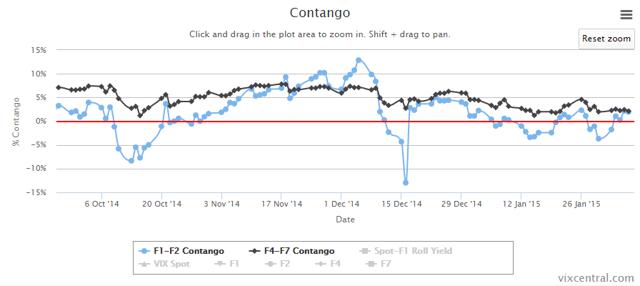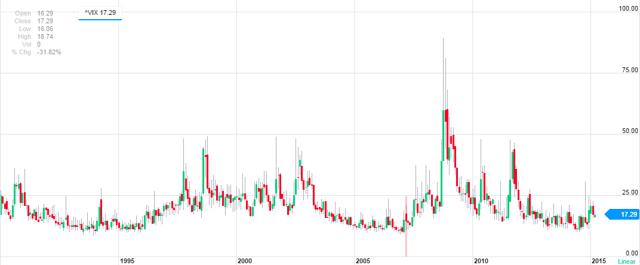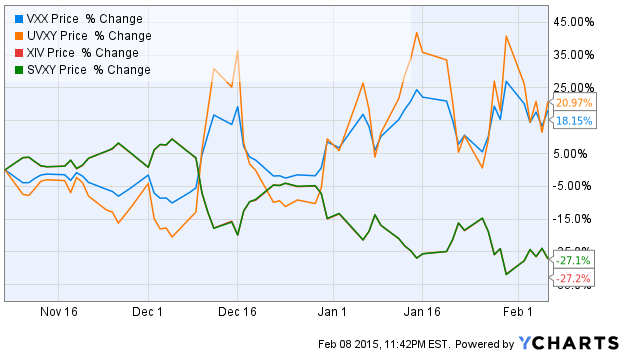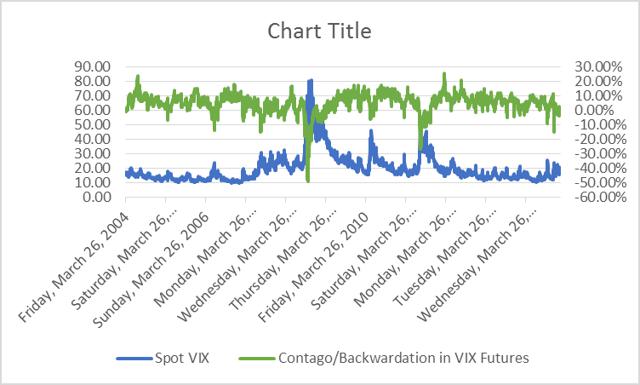Scalper1 News



 All four major VIX short-term futures ETPs are negative over the past six months. Backwardation has occurred much more frequently in the past three months. The VIX is signaling a lack of direction in the market. In this article, my main theme will be what the VIX futures are saying about the market and why you should be patient. We will take a look at some popular VIX ETFs such as the ProShares Ultra VIX Short-Term Futures ETF (NYSEARCA: UVXY ), the ProShares Short VIX Short-Term Futures ETF (NYSEARCA: SVXY ), the VelocityShares Daily Inverse VIX Short-Term ETN (NASDAQ: XIV ), and the iPath S&P 500 VIX Short-Term Futures ETN (NYSEARCA: VXX ). As you can see below, VIX futures have been in backwardation quite frequently, especially when compared to 2012, 2013, and the beginning of 2014. Last month, I published an article that recommended a shift in focus from the pure contango and backwardation strategy to the percentage of backwardation strategy. You can view that article here . I continue to recommend this strategy given the current market conditions. (click to enlarge) Over the past three years, we have enjoyed a relatively subdued VIX. Historically, this is not abnormal in a bull market. However, as seen in the chart below, these periods (within the last 25 years) have only lasted, at most, about five years. (click to enlarge) Chart obtained from Yahoo! Finance by Nathan Buehler If you have followed my past publications, you know I take an optimistic view towards the U.S. economy. I continue to be concerned about the level of debt and liabilities within the U.S. government. It seems, as a global economy, debt has become an acceptable part of the budget. Living beyond your means for a long period of time will eventually have consequences. When those consequences will affect the economy is when politicians begin to address the problem. I don’t see that happening anytime in the near future. The Federal Reserve has undoubtedly, in my opinion, been the number one driver of the VIX for the past five years. Through massive amounts of monetary stimulus and an ever reassuring tone, it has encouraged the market to record highs. My takeaway from current events is that the Federal Reserve will continue to support the market and the U.S. economy at any cost. I expect to see low rates for the foreseeable future unless inflation begins to run over the proposed targets. The current VIX is signaling a lack of direction in the market. There is uncertainty surrounding U.S. monetary policy going forward. When will rates rise and by how much are common questions being discussed. Global growth has been revised downward several times. Investors are unsure if the U.S. can continue to sustain growth in these challenging conditions. This is exactly what the VIX is intended to measure, uncertainty and fear. It is currently right on target. Both UVXY and VXX have outperformed their inverse counterparts over the past three months. This is especially positive for VXX considering it does not have the leverage that UVXY provides. This is something we have not seen, for a prolonged period of time, since 2011. All four instruments are negative over the past six months. As of 2/6/2015, VXX was down less than 1% over the same time period. (click to enlarge) Chart made by Nathan Buehler using historical VIX data obtained from the CBOE As you can see from the data above, over the past 11 years, we have only seen backwardation drop below -10% (significantly) five times. Given the current global economic outlook, I would not be surprised to see the VIX futures testing a -10% backwardation level sometime in 2015. When uncertainty in the VIX presents itself, the best tool to have in your investing portfolio is patience. Sometimes you will have missed opportunities, or feel that way, until you are rewarded for waiting patiently. You only need one correct trade a year in the VIX to outperform the major benchmarks. I have been extremely cautious over the last several months and it has paid off. Nothing has presented enough potential reward to balance the current risk. These back and forth swings in the market only decay the value of short-term ETPs (pro and inverse). My strategy has always been to short the VIX once “extreme” levels are breached. Different periods of economic activity dictate different levels of “extreme”. This strategy can be executed through purchasing inverse products, shorting pro-VIX products, options, or a combination. Please see my library and Instablog for more information on specific strategies. My current recommendation is to avoid all the short-term VIX-related products until a better opportunity presents itself. None of these products are buy-and-hold investments. If you have any questions or are new to trading the VIX, please view my library of articles to gain a better understanding of your risks. As 2015 progresses, I will continue to publish updates on the VIX futures and its related ETPs. I highly appreciate you reading and hope you find this information helpful in your investing decisions. Disclosure: The author has no positions in any stocks mentioned, and no plans to initiate any positions within the next 72 hours. (More…) The author wrote this article themselves, and it expresses their own opinions. The author is not receiving compensation for it (other than from Seeking Alpha). The author has no business relationship with any company whose stock is mentioned in this article. Scalper1 News
All four major VIX short-term futures ETPs are negative over the past six months. Backwardation has occurred much more frequently in the past three months. The VIX is signaling a lack of direction in the market. In this article, my main theme will be what the VIX futures are saying about the market and why you should be patient. We will take a look at some popular VIX ETFs such as the ProShares Ultra VIX Short-Term Futures ETF (NYSEARCA: UVXY ), the ProShares Short VIX Short-Term Futures ETF (NYSEARCA: SVXY ), the VelocityShares Daily Inverse VIX Short-Term ETN (NASDAQ: XIV ), and the iPath S&P 500 VIX Short-Term Futures ETN (NYSEARCA: VXX ). As you can see below, VIX futures have been in backwardation quite frequently, especially when compared to 2012, 2013, and the beginning of 2014. Last month, I published an article that recommended a shift in focus from the pure contango and backwardation strategy to the percentage of backwardation strategy. You can view that article here . I continue to recommend this strategy given the current market conditions. (click to enlarge) Over the past three years, we have enjoyed a relatively subdued VIX. Historically, this is not abnormal in a bull market. However, as seen in the chart below, these periods (within the last 25 years) have only lasted, at most, about five years. (click to enlarge) Chart obtained from Yahoo! Finance by Nathan Buehler If you have followed my past publications, you know I take an optimistic view towards the U.S. economy. I continue to be concerned about the level of debt and liabilities within the U.S. government. It seems, as a global economy, debt has become an acceptable part of the budget. Living beyond your means for a long period of time will eventually have consequences. When those consequences will affect the economy is when politicians begin to address the problem. I don’t see that happening anytime in the near future. The Federal Reserve has undoubtedly, in my opinion, been the number one driver of the VIX for the past five years. Through massive amounts of monetary stimulus and an ever reassuring tone, it has encouraged the market to record highs. My takeaway from current events is that the Federal Reserve will continue to support the market and the U.S. economy at any cost. I expect to see low rates for the foreseeable future unless inflation begins to run over the proposed targets. The current VIX is signaling a lack of direction in the market. There is uncertainty surrounding U.S. monetary policy going forward. When will rates rise and by how much are common questions being discussed. Global growth has been revised downward several times. Investors are unsure if the U.S. can continue to sustain growth in these challenging conditions. This is exactly what the VIX is intended to measure, uncertainty and fear. It is currently right on target. Both UVXY and VXX have outperformed their inverse counterparts over the past three months. This is especially positive for VXX considering it does not have the leverage that UVXY provides. This is something we have not seen, for a prolonged period of time, since 2011. All four instruments are negative over the past six months. As of 2/6/2015, VXX was down less than 1% over the same time period. (click to enlarge) Chart made by Nathan Buehler using historical VIX data obtained from the CBOE As you can see from the data above, over the past 11 years, we have only seen backwardation drop below -10% (significantly) five times. Given the current global economic outlook, I would not be surprised to see the VIX futures testing a -10% backwardation level sometime in 2015. When uncertainty in the VIX presents itself, the best tool to have in your investing portfolio is patience. Sometimes you will have missed opportunities, or feel that way, until you are rewarded for waiting patiently. You only need one correct trade a year in the VIX to outperform the major benchmarks. I have been extremely cautious over the last several months and it has paid off. Nothing has presented enough potential reward to balance the current risk. These back and forth swings in the market only decay the value of short-term ETPs (pro and inverse). My strategy has always been to short the VIX once “extreme” levels are breached. Different periods of economic activity dictate different levels of “extreme”. This strategy can be executed through purchasing inverse products, shorting pro-VIX products, options, or a combination. Please see my library and Instablog for more information on specific strategies. My current recommendation is to avoid all the short-term VIX-related products until a better opportunity presents itself. None of these products are buy-and-hold investments. If you have any questions or are new to trading the VIX, please view my library of articles to gain a better understanding of your risks. As 2015 progresses, I will continue to publish updates on the VIX futures and its related ETPs. I highly appreciate you reading and hope you find this information helpful in your investing decisions. Disclosure: The author has no positions in any stocks mentioned, and no plans to initiate any positions within the next 72 hours. (More…) The author wrote this article themselves, and it expresses their own opinions. The author is not receiving compensation for it (other than from Seeking Alpha). The author has no business relationship with any company whose stock is mentioned in this article. Scalper1 News
Scalper1 News